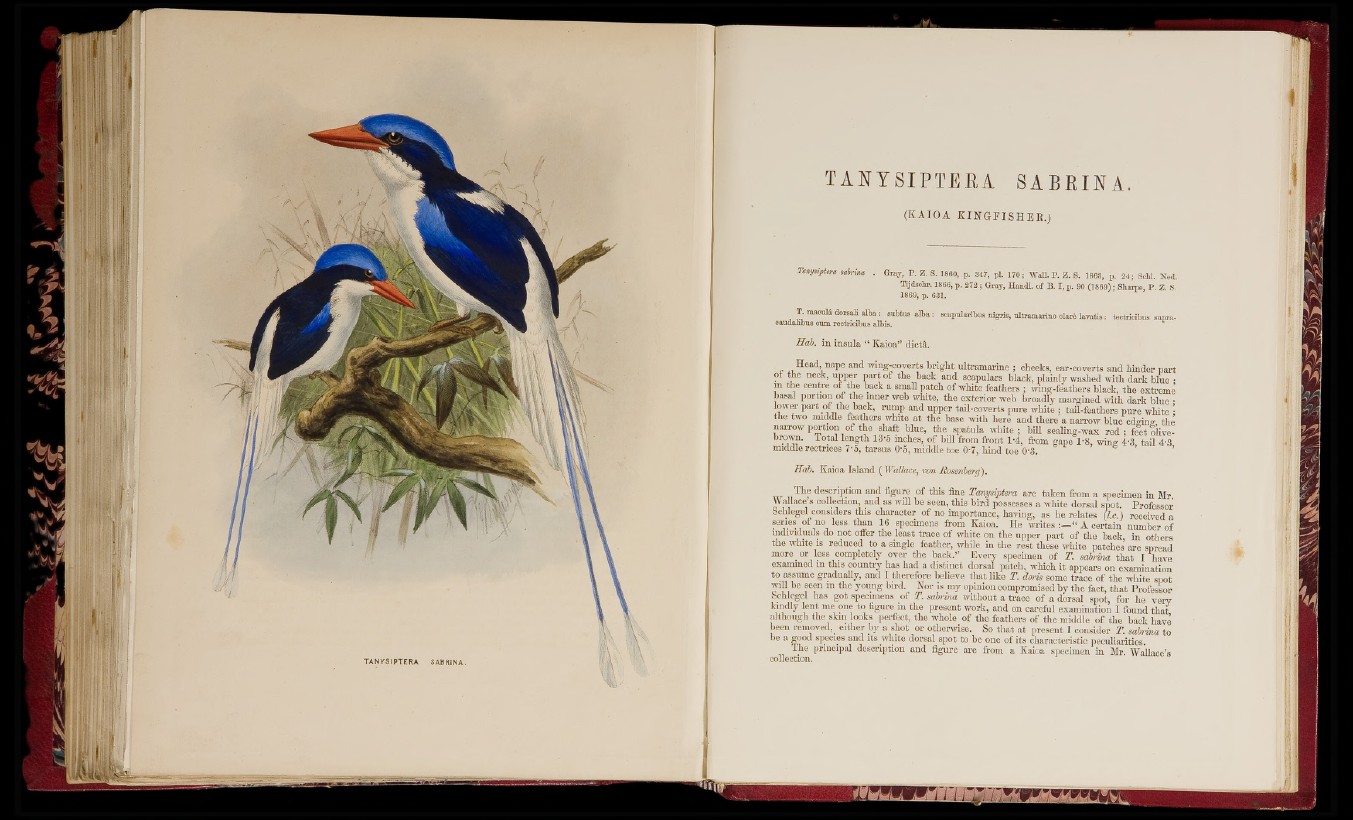
T A N Y S I P T E R A S A B R IN A .
(K A IO A K I N G F I S H E R . )
Gray, F. Z. S. 1860, p. 347, pl. 170; WaU. P. Z. S. 1863, p. 24; ScM. Ned.
Tijdsclu-. 1866, p. 272 ; Gray, Handl. of B. I, p. 90 (1869) ; Sharpe, P. Z. S.
1869, p . 631.
T. maculâ dorsali a lia : su ttu s alba : scapularibus nigris, ultramarino d are lavatis : tectricibus supracaudalibus
cum rectricibus albis.
Hab. in in su la “ Kaioa” dictâ.
- - ------- re.« ~ .aflare.Jl patch __________
basal po rtio n o f th e in n er web white, the ex te rio r web broadfy m a rg in e d 'with'd¡rk“ blue'^
lower p a rt of the back, rump and u pper tail-coverts p u re white ; tail-feathers p ure Avhite
the two middle feathers white a t the base Avith here and th ere a naiTow blue edgino-, the
na rrow pOTtion o f the shaft blue, th e spatula white ; biU sealing-wax red ; feetSlive-
broATO. To ta l len g th 13-o mches, o f bill from fro n t lA , from gape 1-8, wing 4*3 ta il 4*3
middle rectrices 7-5, tarsu s 0-5, middle toe 0-7, hind toe 0-3 . ’ s i ,
Hab. Kaioa Island ( WaUace, von Rosenberg).
The description and figure o f th is fine Tanysiptera a re taken from a specimen in Mr
J allace s collection, aud as will be seen, th is b ird possesses a white dorsal spot. Professor
bchlegel considers th is character o f no importance, having, as h e relates ( l c ) receiA-ed a
series o f no less th an 16 specimens from Kaioa. He Avi-ites A c ertain num ber o f
individuals do n o t offer tb e least trace o f Avliite on th e u pper p a it o f th e back, in others
the white is reduced to a single feather, while in th e re s t these white patches a re spread
more o r less completely over th e back.” Every specimen o f T. sabrina th a t I have
examined iii th is co untry has had a distin ct dorsal patch, which i t appears on examination
to assume gradually, and I therefore believe th a t like T . doris some tra c e o f th e white spot
will be seen in the y oung bfrd. Nor is my opinion compromised b y th e fact, th a t Professor
Schlegel has g o t specimens o f T. sabrina Avithout a trace o f a dorsal spot, for he v e ry
kindly len t me one to figure in th e p resent work, and on careful examination I found th a t
although the skm looks perfect, th e whole o f the feathers o f the middle o f th e back have
been removed, eith e r by a shot o r otherwise. So th a t a t iiresent I consider T. sabrina to
be a good species and its white dorsal spot to be one o f its characteristic peculiarities.
The prmcipal description and figure are from a Kaioa specimen in Mr. WaUace’s
collection.